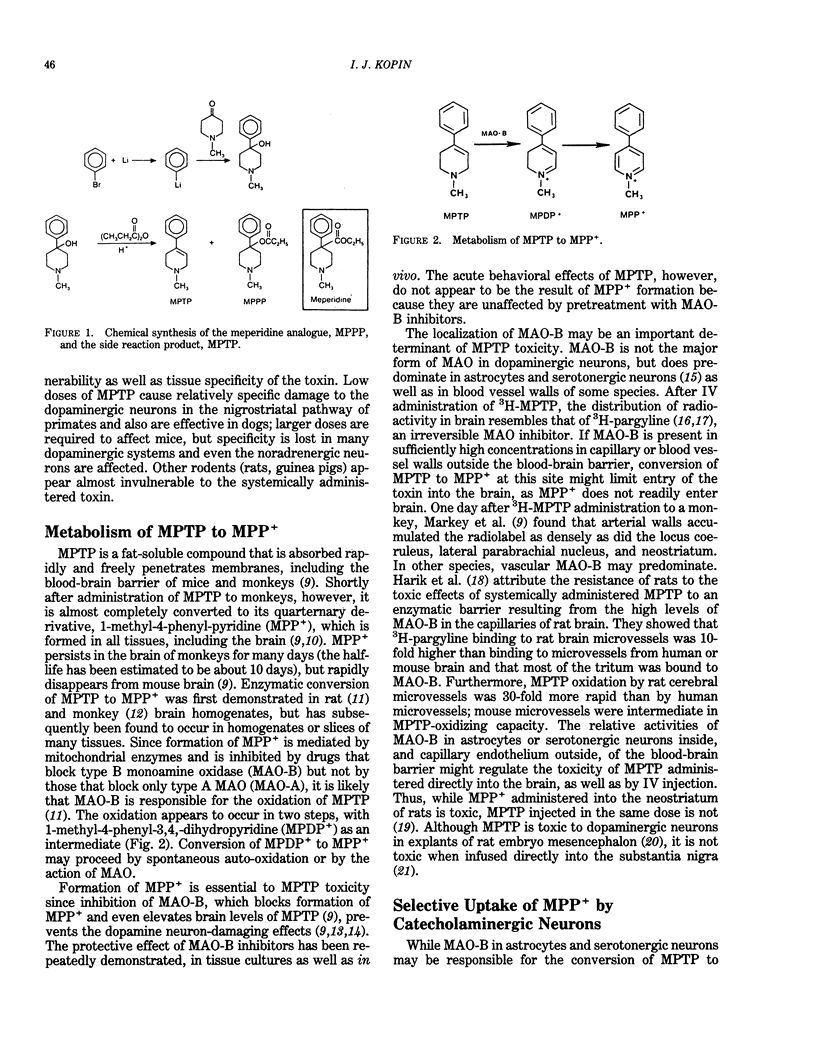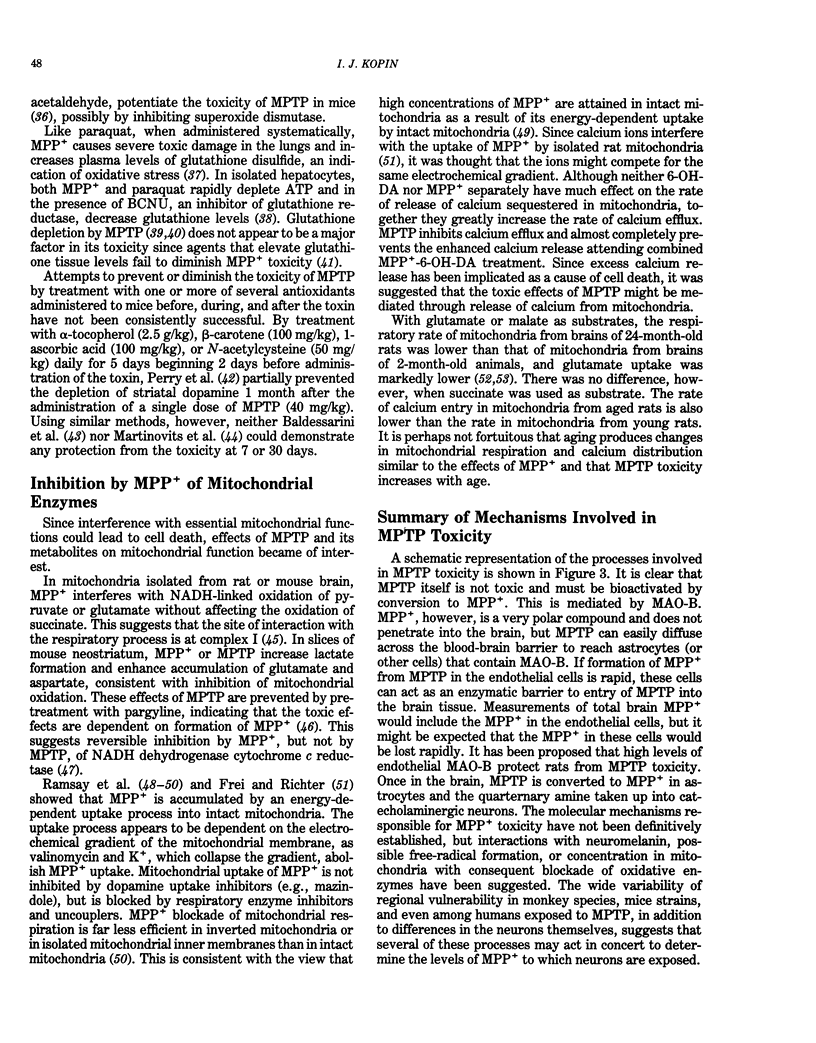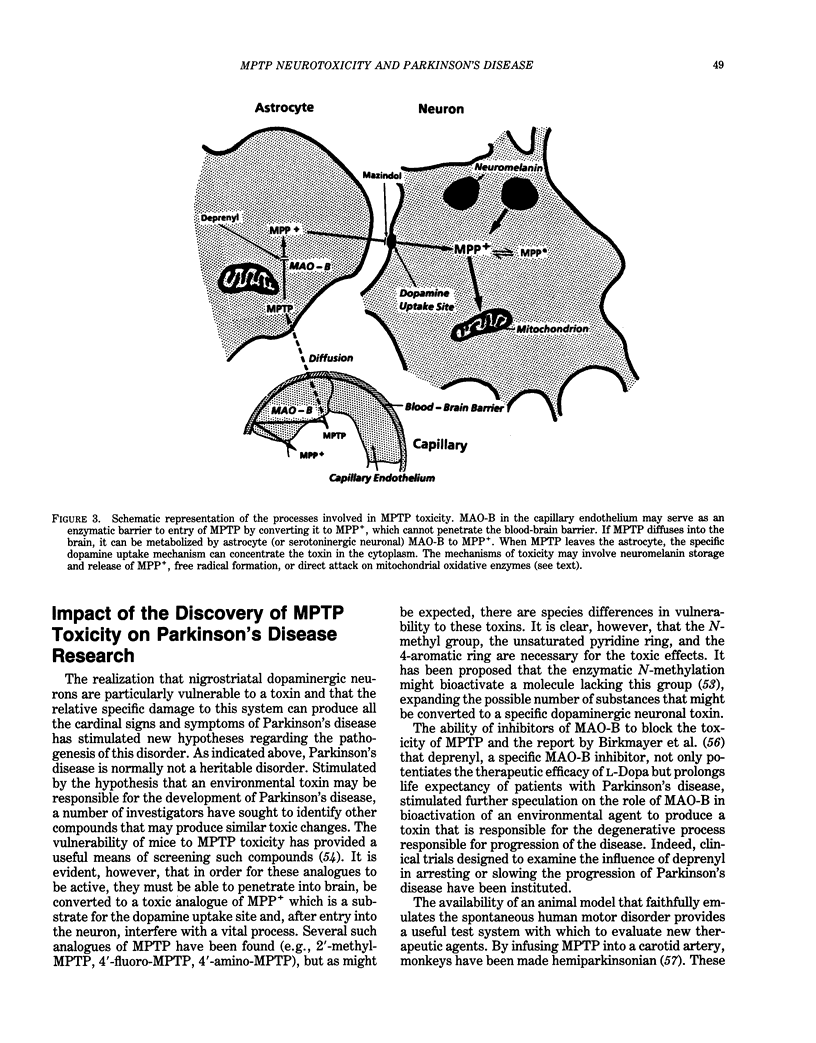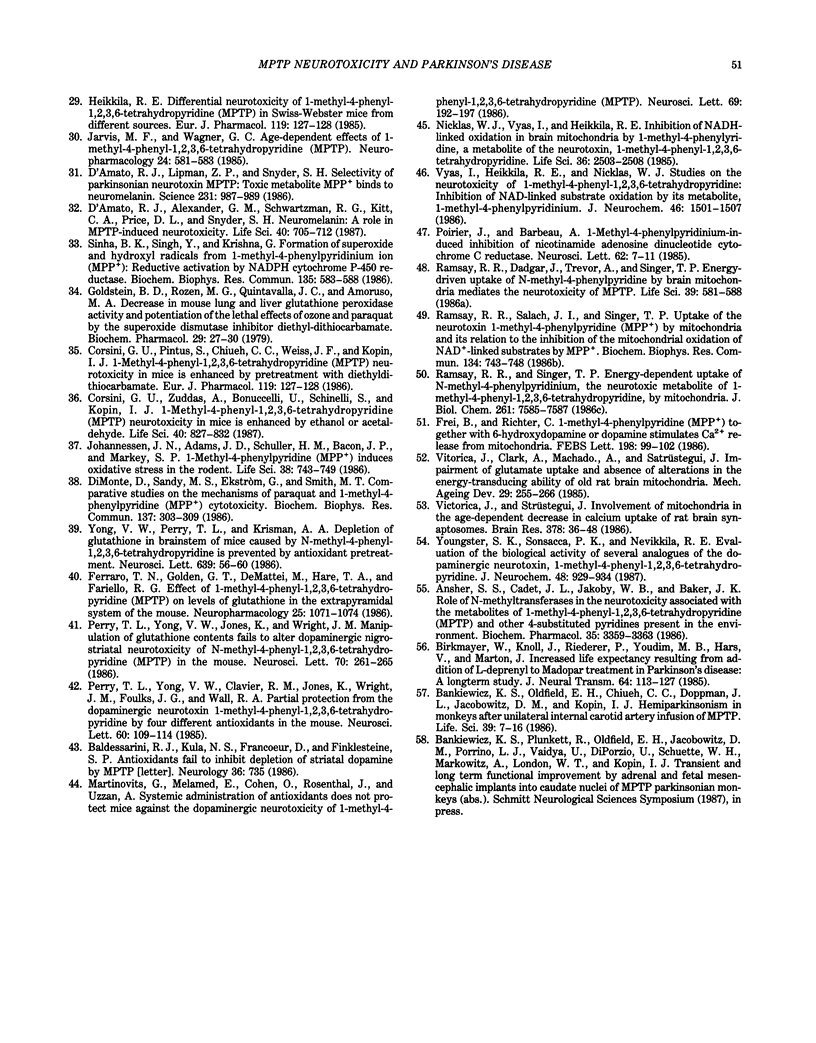Abstract
MPTP (1-methyl-4-phenyl-1,2,3,6-tetrahydropyridine) causes selective destruction of dopaminergic neurons of the nigrostriatal pathway in humans and other primates. It is less specific and much less potent in mice and has only slight effects in rats. Differences in rates and sites of metabolism of MPTP to its active, toxic, highly polar metabolite, MPP+ (1-methyl-4-phenylpyridine), appear to influence species specificity. In rats, type B monoamine oxidase (MAO-B), which mediates the conversion of MPTP to MPP+, may act as an enzymatic barrier at brain microvessels, whereas in primates the enzyme, present mainly in astrocytes, appears important for bioactivation of MPTP into the toxic metabolite. MPP+ is a substrate for catecholamine uptake sites and is concentrated in these neurons. The molecular mechanism of MPP+ toxicity has not been established definitively, but conversion to a free radical or uptake by mitochondria and inhibition of mitochondrial respiratory enzymes, leading to calcium release and cell death have been suggested. The discovery of toxin which causes an animal model of Parkinson's disease has stimulated new research on environmental factors that might contribute to this progressive degenerative disorder and provides a means for assessing new approaches to therapy.
Full text
PDF






Selected References
These references are in PubMed. This may not be the complete list of references from this article.
- Ansher S. S., Cadet J. L., Jakoby W. B., Baker J. K. Role of N-methyltransferases in the neurotoxicity associated with the metabolites of 1-methyl-4-phenyl-1,2,3,6-tetrahydropyridine (MPTP) and other 4-substituted pyridines present in the environment. Biochem Pharmacol. 1986 Oct 1;35(19):3359–3363. doi: 10.1016/0006-2952(86)90436-3. [DOI] [PubMed] [Google Scholar]
- Baldessarini R. J., Kula N. S., Francoeur D., Finklestein S. P. Antioxidants fail to inhibit depletion of striatal dopamine by MPTP. Neurology. 1986 May;36(5):735–735. doi: 10.1212/wnl.36.5.735. [DOI] [PubMed] [Google Scholar]
- Bankiewicz K. S., Oldfield E. H., Chiueh C. C., Doppman J. L., Jacobowitz D. M., Kopin I. J. Hemiparkinsonism in monkeys after unilateral internal carotid artery infusion of 1-methyl-4-phenyl-1,2,3,6-tetrahydropyridine (MPTP). Life Sci. 1986 Jul 7;39(1):7–16. doi: 10.1016/0024-3205(86)90431-5. [DOI] [PubMed] [Google Scholar]
- Birkmayer W., Knoll J., Riederer P., Youdim M. B., Hars V., Marton J. Increased life expectancy resulting from addition of L-deprenyl to Madopar treatment in Parkinson's disease: a longterm study. J Neural Transm. 1985;64(2):113–127. doi: 10.1007/BF01245973. [DOI] [PubMed] [Google Scholar]
- Bradbury A. J., Costall B., Domeney A. M., Jenner P. J., Marsden C. D., Naylor R. J. The neurotoxic actions of 6-hydroxydopamine infused into the rat substantia nigra. Neurosci Lett. 1986 Jun 18;67(2):208–212. doi: 10.1016/0304-3940(86)90399-x. [DOI] [PubMed] [Google Scholar]
- Bradbury A. J., Costall B., Jenner P. G., Kelly M. E., Marsden C. D., Naylor R. J. The effect of 1-methyl-4-phenyl-1,2,3,6-tetrahydropyridine (MPTP) on striatal and limbic catecholamine neurones in white and black mice. Antagonism by monoamine oxidase inhibitors. Neuropharmacology. 1986 Aug;25(8):897–904. doi: 10.1016/0028-3908(86)90016-x. [DOI] [PubMed] [Google Scholar]
- Burns R. S., Chiueh C. C., Markey S. P., Ebert M. H., Jacobowitz D. M., Kopin I. J. A primate model of parkinsonism: selective destruction of dopaminergic neurons in the pars compacta of the substantia nigra by N-methyl-4-phenyl-1,2,3,6-tetrahydropyridine. Proc Natl Acad Sci U S A. 1983 Jul;80(14):4546–4550. doi: 10.1073/pnas.80.14.4546. [DOI] [PMC free article] [PubMed] [Google Scholar]
- Burns R. S., LeWitt P. A., Ebert M. H., Pakkenberg H., Kopin I. J. The clinical syndrome of striatal dopamine deficiency. Parkinsonism induced by 1-methyl-4-phenyl-1,2,3,6-tetrahydropyridine (MPTP). N Engl J Med. 1985 May 30;312(22):1418–1421. doi: 10.1056/NEJM198505303122203. [DOI] [PubMed] [Google Scholar]
- Chiba K., Trevor A., Castagnoli N., Jr Metabolism of the neurotoxic tertiary amine, MPTP, by brain monoamine oxidase. Biochem Biophys Res Commun. 1984 Apr 30;120(2):574–578. doi: 10.1016/0006-291x(84)91293-2. [DOI] [PubMed] [Google Scholar]
- Chiueh C. C., Markey S. P., Burns R. S., Johannessen J. N., Pert A., Kopin I. J. Neurochemical and behavioral effects of systemic and intranigral administration of N-methyl-4-phenyl-1,2,3,6-tetrahydropyridine in the rat. Eur J Pharmacol. 1984 Apr 20;100(2):189–194. doi: 10.1016/0014-2999(84)90221-8. [DOI] [PubMed] [Google Scholar]
- Corsini G. U., Pintus S., Chiueh C. C., Weiss J. F., Kopin I. J. 1-Methyl-4-phenyl-1,2,3,6-tetrahydropyridine (MPTP) neurotoxicity in mice is enhanced by pretreatment with diethyldithiocarbamate. Eur J Pharmacol. 1985 Dec 10;119(1-2):127–128. doi: 10.1016/0014-2999(85)90331-0. [DOI] [PubMed] [Google Scholar]
- Corsini G. U., Pintus S., Chiueh C. C., Weiss J. F., Kopin I. J. 1-Methyl-4-phenyl-1,2,3,6-tetrahydropyridine (MPTP) neurotoxicity in mice is enhanced by pretreatment with diethyldithiocarbamate. Eur J Pharmacol. 1985 Dec 10;119(1-2):127–128. doi: 10.1016/0014-2999(85)90331-0. [DOI] [PubMed] [Google Scholar]
- Corsini G. U., Zuddas A., Bonuccelli U., Schinelli S., Kopin I. J. 1-Methyl-4-phenyl-1,2,3,6-tetrahydropyridine (MPTP) neurotoxicity in mice is enhanced by ethanol or acetaldehyde. Life Sci. 1987 Mar 2;40(9):827–832. doi: 10.1016/0024-3205(87)90030-0. [DOI] [PubMed] [Google Scholar]
- D'Amato R. J., Alexander G. M., Schwartzman R. J., Kitt C. A., Price D. L., Snyder S. H. Neuromelanin: a role in MPTP-induced neurotoxicity. Life Sci. 1987 Feb 23;40(8):705–712. doi: 10.1016/0024-3205(87)90297-9. [DOI] [PubMed] [Google Scholar]
- D'Amato R. J., Lipman Z. P., Snyder S. H. Selectivity of the parkinsonian neurotoxin MPTP: toxic metabolite MPP+ binds to neuromelanin. Science. 1986 Feb 28;231(4741):987–989. doi: 10.1126/science.3080808. [DOI] [PubMed] [Google Scholar]
- Davis G. C., Williams A. C., Markey S. P., Ebert M. H., Caine E. D., Reichert C. M., Kopin I. J. Chronic Parkinsonism secondary to intravenous injection of meperidine analogues. Psychiatry Res. 1979 Dec;1(3):249–254. doi: 10.1016/0165-1781(79)90006-4. [DOI] [PubMed] [Google Scholar]
- Di Monte D., Sandy M. S., Ekström G., Smith M. T. Comparative studies on the mechanisms of paraquat and 1-methyl-4-phenylpyridine (MPP+) cytotoxicity. Biochem Biophys Res Commun. 1986 May 29;137(1):303–309. doi: 10.1016/0006-291x(86)91210-6. [DOI] [PubMed] [Google Scholar]
- Duvoisin R. C. Is Parkinson's disease acquired or inherited? Can J Neurol Sci. 1984 Feb;11(1 Suppl):151–155. doi: 10.1017/s031716710004631x. [DOI] [PubMed] [Google Scholar]
- Ferraro T. N., Golden G. T., DeMattei M., Hare T. A., Fariello R. G. Effect of 1-methyl-4-phenyl-1,2,3,6-tetrahydropyridine (MPTP) on levels of glutathione in the extrapyramidal system of the mouse. Neuropharmacology. 1986 Sep;25(9):1071–1074. doi: 10.1016/0028-3908(86)90205-4. [DOI] [PubMed] [Google Scholar]
- Frei B., Richter C. N-methyl-4-phenylpyridine (MMP+) together with 6-hydroxydopamine or dopamine stimulates Ca2+ release from mitochondria. FEBS Lett. 1986 Mar 17;198(1):99–102. doi: 10.1016/0014-5793(86)81192-9. [DOI] [PubMed] [Google Scholar]
- Goldstein B. D., Rozen M. G., Quintavalla J. C., Amoruso M. A. Decrease in mouse lung and liver glutathione peroxidase activity and potentiation of the lethal effects of ozone and paraquat by the superoxide dismutase inhibitor diethyldithiocarbamate. Biochem Pharmacol. 1979;28(1):27–30. doi: 10.1016/0006-2952(79)90265-x. [DOI] [PubMed] [Google Scholar]
- Heikkila R. E., Manzino L., Cabbat F. S., Duvoisin R. C. Protection against the dopaminergic neurotoxicity of 1-methyl-4-phenyl-1,2,5,6-tetrahydropyridine by monoamine oxidase inhibitors. Nature. 1984 Oct 4;311(5985):467–469. doi: 10.1038/311467a0. [DOI] [PubMed] [Google Scholar]
- Irwin I., Langston J. W. Selective accumulation of MPP+ in the substantia nigra: a key to neurotoxicity? Life Sci. 1985 Jan 21;36(3):207–212. doi: 10.1016/0024-3205(85)90060-8. [DOI] [PubMed] [Google Scholar]
- Jarvis M. F., Wagner G. C. Age-dependent effects of 1-methyl-4-phenyl-1,2,5,6-tetrahydropyridine (MPTP). Neuropharmacology. 1985 Jun;24(6):581–583. doi: 10.1016/0028-3908(85)90068-1. [DOI] [PubMed] [Google Scholar]
- Javitch J. A., Snyder S. H. Uptake of MPP(+) by dopamine neurons explains selectivity of parkinsonism-inducing neurotoxin, MPTP. Eur J Pharmacol. 1984 Nov 13;106(2):455–456. doi: 10.1016/0014-2999(84)90740-4. [DOI] [PubMed] [Google Scholar]
- Jenner P., Rupniak N. M., Rose S., Kelly E., Kilpatrick G., Lees A., Marsden C. D. 1-Methyl-4-phenyl-1,2,3,6-tetrahydropyridine-induced parkinsonism in the common marmoset. Neurosci Lett. 1984 Sep 7;50(1-3):85–90. doi: 10.1016/0304-3940(84)90467-1. [DOI] [PubMed] [Google Scholar]
- Johannessen J. N., Adams J. D., Schuller H. M., Bacon J. P., Markey S. P. 1-Methyl-4-phenylpyridine (MPP+) induces oxidative stress in the rodent. Life Sci. 1986 Feb 24;38(8):743–749. doi: 10.1016/0024-3205(86)90589-8. [DOI] [PubMed] [Google Scholar]
- Langston J. W., Ballard P. Parkinsonism induced by 1-methyl-4-phenyl-1,2,3,6-tetrahydropyridine (MPTP): implications for treatment and the pathogenesis of Parkinson's disease. Can J Neurol Sci. 1984 Feb;11(1 Suppl):160–165. doi: 10.1017/s0317167100046333. [DOI] [PubMed] [Google Scholar]
- Langston J. W., Ballard P., Tetrud J. W., Irwin I. Chronic Parkinsonism in humans due to a product of meperidine-analog synthesis. Science. 1983 Feb 25;219(4587):979–980. doi: 10.1126/science.6823561. [DOI] [PubMed] [Google Scholar]
- Langston J. W., Irwin I., Langston E. B., Forno L. S. 1-Methyl-4-phenylpyridinium ion (MPP+): identification of a metabolite of MPTP, a toxin selective to the substantia nigra. Neurosci Lett. 1984 Jul 13;48(1):87–92. doi: 10.1016/0304-3940(84)90293-3. [DOI] [PubMed] [Google Scholar]
- Langston J. W., Irwin I., Langston E. B., Forno L. S. Pargyline prevents MPTP-induced parkinsonism in primates. Science. 1984 Sep 28;225(4669):1480–1482. doi: 10.1126/science.6332378. [DOI] [PubMed] [Google Scholar]
- Markey S. P., Johannessen J. N., Chiueh C. C., Burns R. S., Herkenham M. A. Intraneuronal generation of a pyridinium metabolite may cause drug-induced parkinsonism. Nature. 1984 Oct 4;311(5985):464–467. doi: 10.1038/311464a0. [DOI] [PubMed] [Google Scholar]
- Martinovits G., Melamed E., Cohen O., Rosenthal J., Uzzan A. Systemic administration of antioxidants does not protect mice against the dopaminergic neurotoxicity of 1-methyl-4-phenyl-1,2,5,6-tetrahydropyridine (MPTP). Neurosci Lett. 1986 Aug 29;69(2):192–197. doi: 10.1016/0304-3940(86)90602-6. [DOI] [PubMed] [Google Scholar]
- Mytilineou C., Cohen G. 1-methyl-4-phenyl-1,2,3,6-tetrahydropyridine destroys dopamine neurons in explants of rat embryo mesencephalon. Science. 1984 Aug 3;225(4661):529–531. doi: 10.1126/science.6610939. [DOI] [PubMed] [Google Scholar]
- Nicklas W. J., Vyas I., Heikkila R. E. Inhibition of NADH-linked oxidation in brain mitochondria by 1-methyl-4-phenyl-pyridine, a metabolite of the neurotoxin, 1-methyl-4-phenyl-1,2,5,6-tetrahydropyridine. Life Sci. 1985 Jul 1;36(26):2503–2508. doi: 10.1016/0024-3205(85)90146-8. [DOI] [PubMed] [Google Scholar]
- Parsons B., Rainbow T. C. High-affinity binding sites for [3H]MPTP may correspond to monamine oxidase. Eur J Pharmacol. 1984 Jul 13;102(2):375–377. doi: 10.1016/0014-2999(84)90274-7. [DOI] [PubMed] [Google Scholar]
- Perry T. L., Yong V. W., Clavier R. M., Jones K., Wright J. M., Foulks J. G., Wall R. A. Partial protection from the dopaminergic neurotoxin N-methyl-4-phenyl-1,2,3,6-tetrahydropyridine by four different antioxidants in the mouse. Neurosci Lett. 1985 Sep 30;60(2):109–114. doi: 10.1016/0304-3940(85)90229-0. [DOI] [PubMed] [Google Scholar]
- Perry T. L., Yong V. W., Jones K., Wright J. M. Manipulation of glutathione contents fails to alter dopaminergic nigrostriatal neurotoxicity of N-methyl-4-phenyl-1,2,3,6-tetrahydropyridine (MPTP) in the mouse. Neurosci Lett. 1986 Oct 8;70(2):261–265. doi: 10.1016/0304-3940(86)90474-x. [DOI] [PubMed] [Google Scholar]
- Pileblad E., Carlsson A. Catecholamine-uptake inhibitors prevent the neurotoxicity of 1-methyl-4-phenyl-1,2,3,6-tetrahydropyridine (MPTP) in mouse brain. Neuropharmacology. 1985 Jul;24(7):689–692. doi: 10.1016/0028-3908(85)90114-5. [DOI] [PubMed] [Google Scholar]
- Poirier J., Barbeau A. 1-Methyl-4-phenyl-pyridinium-induced inhibition of nicotinamide adenosine dinucleotide cytochrome c reductase. Neurosci Lett. 1985 Nov 20;62(1):7–11. doi: 10.1016/0304-3940(85)90276-9. [DOI] [PubMed] [Google Scholar]
- Rainbow T. C., Parsons B., Wieczorek C. M., Manaker S. Localization in rat brain of binding sites for parkinsonian toxin MPTP: similarities with [3H]pargyline binding to monoamine oxidase. Brain Res. 1985 Mar 25;330(2):337–342. doi: 10.1016/0006-8993(85)90694-8. [DOI] [PubMed] [Google Scholar]
- Ramsay R. R., Dadgar J., Trevor A., Singer T. P. Energy-driven uptake of N-methyl-4-phenylpyridine by brain mitochondria mediates the neurotoxicity of MPTP. Life Sci. 1986 Aug 18;39(7):581–588. doi: 10.1016/0024-3205(86)90037-8. [DOI] [PubMed] [Google Scholar]
- Ramsay R. R., Salach J. I., Singer T. P. Uptake of the neurotoxin 1-methyl-4-phenylpyridine (MPP+) by mitochondria and its relation to the inhibition of the mitochondrial oxidation of NAD+-linked substrates by MPP+. Biochem Biophys Res Commun. 1986 Jan 29;134(2):743–748. doi: 10.1016/s0006-291x(86)80483-1. [DOI] [PubMed] [Google Scholar]
- Ramsay R. R., Singer T. P. Energy-dependent uptake of N-methyl-4-phenylpyridinium, the neurotoxic metabolite of 1-methyl-4-phenyl-1,2,3,6-tetrahydropyridine, by mitochondria. J Biol Chem. 1986 Jun 15;261(17):7585–7587. [PubMed] [Google Scholar]
- Ricaurte G. A., Langston J. W., DeLanney L. E., Irwin I., Brooks J. D. Dopamine uptake blockers protect against the dopamine depleting effect of 1-methyl-4-phenyl-1,2,3,6-tetrahydropyridine (MPTP) in the mouse striatum. Neurosci Lett. 1985 Sep 6;59(3):259–264. doi: 10.1016/0304-3940(85)90141-7. [DOI] [PubMed] [Google Scholar]
- Sahgal A., Andrews J. S., Biggins J. A., Candy J. M., Edwardson J. A., Keith A. B., Turner J. D., Wright C. N-methyl-4-phenyl-1,2,3,6-tetrahydropyridine (MPTP) affects locomotor activity without producing a nigrostriatal lesion in the rat. Neurosci Lett. 1984 Jul 27;48(2):179–184. doi: 10.1016/0304-3940(84)90016-8. [DOI] [PubMed] [Google Scholar]
- Schultz W., Scarnati E., Sundström E., Tsutsumi T., Jonsson G. The catecholamine uptake blocker nomifensine protects against MPTP-induced parkinsonism in monkeys. Exp Brain Res. 1986;63(1):216–220. doi: 10.1007/BF00235666. [DOI] [PubMed] [Google Scholar]
- Sinha B. K., Singh Y., Krishna G. Formation of superoxide and hydroxyl radicals from 1-methyl-4-phenylpyridinium ion (MPP+): reductive activation by NADPH cytochrome P-450 reductase. Biochem Biophys Res Commun. 1986 Mar 13;135(2):583–588. doi: 10.1016/0006-291x(86)90033-1. [DOI] [PubMed] [Google Scholar]
- Sundström E., Jonsson G. Pharmacological interference with the neurotoxic action of 1-methyl-4-phenyl-1,2,3,6-tetrahydropyridine (MPTP) on central catecholamine neurons in the mouse. Eur J Pharmacol. 1985 Apr 16;110(3):293–299. doi: 10.1016/0014-2999(85)90555-2. [DOI] [PubMed] [Google Scholar]
- Vitorica J., Clark A., Machado A., Satrústegui J. Impairment of glutamate uptake and absence of alterations in the energy-transducing ability of old rat brain mitochondria. Mech Ageing Dev. 1985 Mar;29(3):255–266. doi: 10.1016/0047-6374(85)90066-1. [DOI] [PubMed] [Google Scholar]
- Vyas I., Heikkila R. E., Nicklas W. J. Studies on the neurotoxicity of 1-methyl-4-phenyl-1,2,3,6-tetrahydropyridine: inhibition of NAD-linked substrate oxidation by its metabolite, 1-methyl-4-phenylpyridinium. J Neurochem. 1986 May;46(5):1501–1507. doi: 10.1111/j.1471-4159.1986.tb01768.x. [DOI] [PubMed] [Google Scholar]
- Westlund K. N., Denney R. M., Kochersperger L. M., Rose R. M., Abell C. W. Distinct monoamine oxidase A and B populations in primate brain. Science. 1985 Oct 11;230(4722):181–183. doi: 10.1126/science.3875898. [DOI] [PubMed] [Google Scholar]
- Yong V. W., Perry T. L., Krisman A. A. Depletion of glutathione in brainstem of mice caused by N-methyl-4-phenyl-1,2,3,6-tetrahydropyridine is prevented by antioxidant pretreatment. Neurosci Lett. 1986 Jan 2;63(1):56–60. doi: 10.1016/0304-3940(86)90012-1. [DOI] [PubMed] [Google Scholar]
- Youngster S. K., Sonsalla P. K., Heikkila R. E. Evaluation of the biological activity of several analogs of the dopaminergic neurotoxin 1-methyl-4-phenyl-1,2,3,6-tetrahydropyridine. J Neurochem. 1987 Mar;48(3):929–934. doi: 10.1111/j.1471-4159.1987.tb05606.x. [DOI] [PubMed] [Google Scholar]


